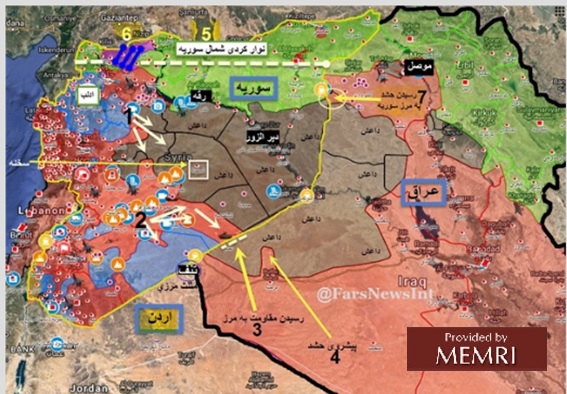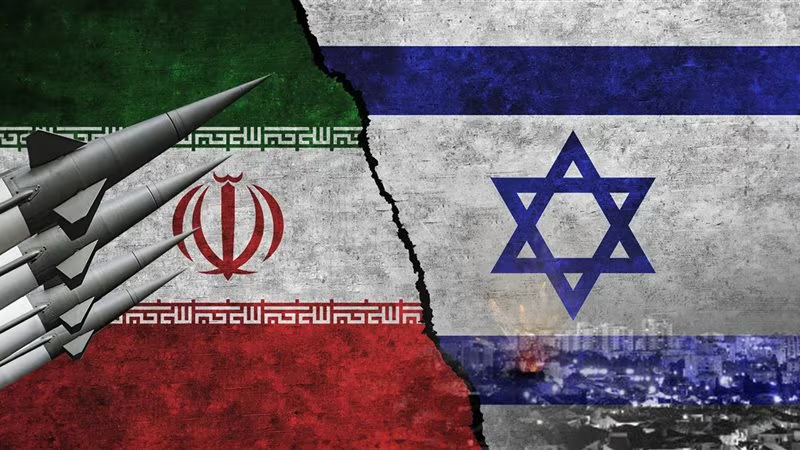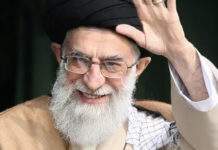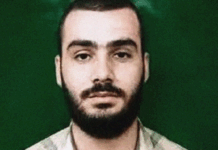Autor: N. Mozes*
Wprowadzenie
9 czerwca 2017 r. siły osi oporu, którym przewodzą Iran i reżim prezydenta syryjskiego Baszara Al-Assada, doszły do granicy syryjsko-irackiej. Jest to ważne osiągnięcie wobec USA i ich sojuszników i nie tylko podnosi morale oporu, ale jest kluczowe w dalszej walce o przyszłość Syrii i równowagę sił w regionie. Obecność osi oporu na tej granicy tworzy ciągłość terytorialną przez Iran, Irak, Syrię i Liban do Morza Śródziemnego, wzmacniając oś oraz nie dopuszczając do interwencji USA w Syrii i konsolidacji ich obecności na tym terenie.
Bitwę o granicę prowadzą obie strony i kieruje nią głównie Iran pod dowództwem dowódcy Sił Kuds Korpusu Strażników Rewolucji Islamskiej (IRGC), Kassema Soleimaniego. Siły reżimu Assada i jego sojuszników – IRGC, Hezbollahu, irackich milicji szyickich i innych – dotarły do granicy od strony syryjskiej. Równocześnie siły Al Haszd Al Sza’bi, większość z nich lojalna wobec Iranu, dotarły do granicy od strony irackiej.
Region, w którym toczy się bitwa od strony syryjskiej, jest głównie niezamieszkałą pustynią. Państwo Islamskie (ISIS) kontroluje tam kilka obszarów – Al-Bukamal, Deir Al-Zor i Palmirę – ale w drodze do granicy syryjsko-irackiej można uniknąć starcia z tymi obszarami. Jedyna barierą, jaka stała między tymi siłami a granicą, były wojska USA. Według doniesień w prasie arabskiej, głównie prasie związanej z osią oporu, USA przeprowadziły ostatnio operacje, by nie dopuścić siły osi do osiągnięcia ciągłości terytorialnej i przejęcia panowania nad granicą Irak-Syria-Jordania, i próbowały stworzyć „strefy bezkonfliktowe” w południowej Syrii na granicy z Jordanią oraz w regionie Al-Tanf w pobliżu trójkąta granicznego Irak-Syria-Jordania, gdzie siły USA są skoncentrowane wraz z siłami opozycji syryjskiej, którą popierają. Te starania wyrażają zasadnicza zmianę w polityce USA wobec kryzysu syryjskiego, jaka zaczęła się, kiedy prezydent Trump objął urząd.
W tej sytuacji media osi oporu przekazują jawne i bezpośrednie groźby wobec USA i ich sił działających w Syrii i w regionie. Należy podkreślić, że poza trzema nalotami na konwoje sił osi oporu w regionie Al-Tanf i ostrzeżeniami przekazanymi Iranowi o ostrej reakcji USA, gdyby żołnierze USA zostali zaatakowani, USA nie zrobiły wiele, by powstrzymać siły osi oporu przed dotarciem do granicy syryjsko-irackiej.
Mimo ograniczonego charakteru akcji USA, którym nie udało się przeszkodzić siłom osi oporu w dotarciu do granicy, te siły obawiają się, że USA będą działać, by nie dopuścić do konsolidacji ich obecności na granicy syryjsko-irackiej i dlatego grożą, że jeśli USA dokonają bardziej intensywnych nalotów, będzie to „równoznaczne z wypowiedzeniem wojny”[1].
Równocześnie ze staraniami reżimu syryjskiego i jego sojuszników przejęcia granicy Irak-Syria, oś działa także na rzecz ustanowienia swojej obecności na granicy syryjsko-jordańskiej. Wywołuje to poważne obawy w Jordanii, doprowadzając ten kraj do odejścia od niejasnej polityki, jaką prowadził dotąd w sprawie wojny syryjskiej i do grożenia akcją wojskową na ziemi syryjskiej.
Niniejsza praca [nie spolszczona] jest przeglądem rozwoju sytuacji na granicy Syria-Irak-Jordania.
Media Close To Assad Regime And Hizbullah: High Likelihood Of Direct Clash Between U.S. And Resistance Forces
The resistance axis forces attribute great importance to the battle for control of the Iraq-Syria border and its ramifications for the Syria war and the balance of power in the region; control of this border will give them territorial continuity from Iran via Iraq and Syria to Lebanon and the Israel border. For them, the main battle is not with ISIS but with the U.S., which was the only obstacle that could have halted their advance towards the border. For this reason, the regime forces chose the quickest route, which did not require encounters with the ISIS forces, concentrated in Deir Al-Zor and Al-Bukamal areas.
The Iranian news agency Fars clarified the importance Iran ascribes to the campaign for the Syria-Iraq-Jordan border, explaining that it is intended to thwart the U.S. plan to partition Syria, a plan that also threatens Iran. The report stated that today Syria is effectively divided between the Kurds, who are supported by the U.S. and are acting to expand the areas under their control in northern Syria; Turkey, which also controls large parts of northern Syria, and the Syrian regime and its allies, which control the coast and the Damascus area. It described the developments on the ground at length, illustrating them with a map (see below). „America,” it said, „wants to link the northeastern part [of the country, which is controlled by the Kurds] with the southeastern part, which is why it has stepped up its activity in the Al-Tanf area. The Syrian Army and the resistance forces began to move east along several routes… [One of these routes led to] Al-Tanf (no. 2 in the map below)… where the U.S. has drawn a 'red line’, 50 kilometers long, vis-a-vis the Syrian and resistance forces. In order to complete the resistance [axis] plan, [the forces on both sides of] the Syria-Iraq border must meet, and to that end Al-Hashd Al-Sha’bi came from Ninveh to the Syria border [no. 7 in map below]. The resistance did not heed the American red line, and despite the American attack, [its forces in Iraq] reached [a point] 50 km north[east] of Al-Tanf (no. 3 on map).
„The assessment is that America will not attack the resistance forces, because its goal is not necessarily to control the border, and also [because] it assumes that, in response, the Syrian Army or its allies will retaliate by attacking the concentration [of U.S. forces in Syria] with ground-to-ground missiles.
„The resistance wants to destroy ISIS on the Syria-Iraq border and thwart the U.S. plan to dismember Syria, and the basis for [achieving] this is the creation of a corridor.
„Iran regards the dismemberment of Syria as a threat to its [own] security. That is why it is fighting, and America knows that Iran will realize its aim and control the border. The U.S. and Saudi Arabia cannot form a coalition against Iran and expect Iran to sit idly by. The imbroglio in eastern Syria has only begun, and stormy days are ahead of us.”[2]
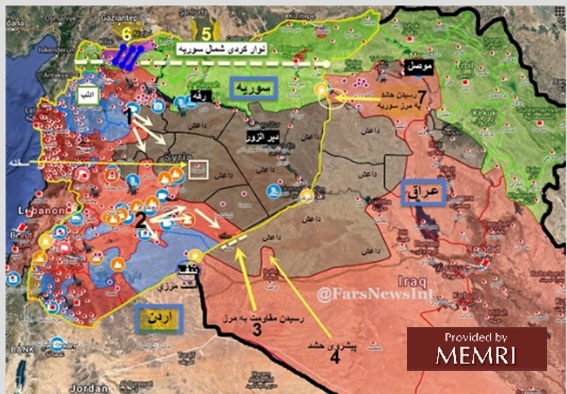
Source: Tasnim, Iran, June 13, 2017.
Ibrahim Al-Amin, chairman of the editorial board of the Lebanese daily Al-Akhbar, which is close to Hizbullah, wrote that the battle for the border was aimed at creating „safe [territorial] continuity from Tehran to Palestine” and called „the American occupation and influence in the region” the new target of the resistance axis. He wrote: „As for the great crisis in Syria and Iraq, many in our land and among the elements involved in the battle are ignoring the essential aspect of the events concerning the new dimension of the resistance movement against the American occupation and influence in the region and against the Israeli occupation of Arab lands…” According to Al-Amin, the battle will not only determine the future of the Middle East, but will „determine the rules for the influence of the global [forces] on our region.”[3]
In order to ensure their control of the border region, in recent weeks the resistance axis forces have used a pincers maneuver, approaching the Syria-Iraq border from both sides of it under the guidance and leadership of IRGC Qods Force commander Qassem Soleimani. Syrian Army troops and forces of the Syrian regime’s allies, from Hizbullah and the Iraqi and Afghan Shi’ite militias fighting alongside the Assad regime almost from the beginning of the war, have been on the march towards the border, while at the same time the Al-Hashd Al-Sha’bi forces loyal to Iran have done the same from the Iraqi side.
This pincers maneuver was accompanied by direct and explicit messages, mainly from media and elements associated with the resistance camp rather than the Syrian regime itself, threatening the U.S. forces and warnings them not to intervene in the fighting. Ibrahim Al-Amin stated that the resistance axis forces would not „stop expanding [their control in eastern Syria] and defending it, regardless of the cost,” and warned about „a very likely confrontation between Syria’s allies, Hizbullah and IRGC forces, and U.S. forces, if the latter decide to involve themselves directly in the fighting alongside the armed [Syrian opposition] groups… This possibility,” he added, „must be taken very seriously, for it points to [the emergence of] a new kind of confrontation in Syria and perhaps even outside it.”[4]
Threats By The Resistance Axis: The Americans And Their Allies Will Pay A High Price If They Enter Syrian Territory
„A senior official in the resistance axis” made similar comments to Al-Akhbar: „Syria and its allies are determined to control the desert and border regions, and we will not allow the Americans to control them, at any cost… We are willing to [confront] you up to the very edge of the abyss and to the very last line of battle.” The source warned that if the Americans decide to intervene directly, „we will have no problem confronting them. We have been fighting their proxies throughout the years of the war, and now, at this decisive stage, we will not spare any efforts to secure a victory. We agree with the Syrian Army and [with Syria’s other] allies that the top priority is to capture the border and prevent the Americans from achieving their aim.”[5] Hizbullah’s Al-I’lam Al-Harbi website cited a „knowledgeable source” as saying: „The Americans and their allies must know that they will pay dearly and will become targets if they step on Syrian soil…”[6]
On June 14, 2017, Hossein Dalirian, who writes for the Iranian news agency Fars and who is close to the IRGC, reported that resistance axis forces had deployed an improved Fajr missile launcher near Al-Tanf.[7]
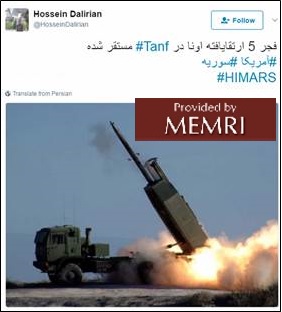
Hizbullah’s Al-Manar TV posted footage of a U.S. drone, released by the „Joint Command of Syria Allies,” allegedly filmed from an Iranian drone that was tracking the American one over the Syrian desert, indicating Iran’s ability „to confront U.S. aggression.”[8]
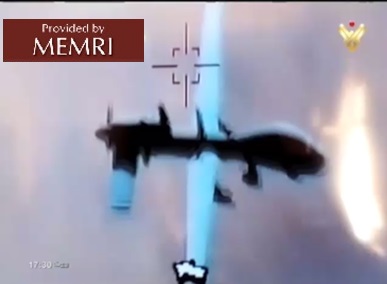
Footage posted by Al-Manar allegedly shows U.S. drone in the crosshairs of an Iranian drone that was tracking it over the Syrian desert (English.almanar.com.lb, June 7, 2017)
The advance of the Syrian regime forces and their allies towards the border encountered limited resistance from the U.S. and its allies, mainly near Al-Tanf near the Syria-Iraq-Jordan border triangle. According to some reports, the U.S. arrived at understandings with Russia about maintaining a 55-km „deconfliction zone” in that area which regime forces will not be allowed to enter. In order to enforce this, on three separate occasions the U.S. reportedly had Coalition planes bomb convoys of regime and pro-regime forces moving towards the area.[9] It also dropped leaflets warning regime forces within the deconfliction zone to leave it, and, according to the Rai Al-Yawm website, relayed messages to Iran that it would not avoid hitting Iranian targets in Syria, Iraq and even Iran itself if any U.S. troops were harmed.[10]
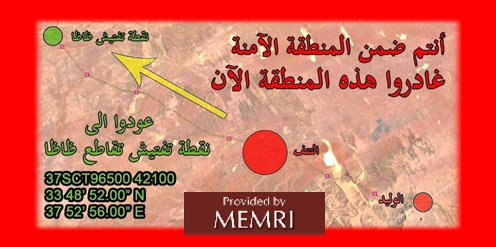
Leaflet dropped by Coalition forces in the Al-Tanf area: „You are deconfliction zone. Leave the area immediately and retreat to the Zaza checkpoint”(Source: enabbaladi.net, May 29, 2017)
So far, the resistance camp forces have refrained from retaliating for the U.S. airstrikes, but the commander of the „Syria Allies Operations Room” threatened: „The U.S. knows very well that the blood of the Syrian people and of the Arab Syrian army and its allies is not cheap, and that [these forces] have the ability to attack concentrations of [U.S.] forces in Syria and in the region, should circumstances require this. [These forces] have rocket systems and other weapons systems, and there are U.S. forces stationed in the region. The lack of response from Syria’s allies is not proof of weakness… This restraint and lack of response will not continue very long if the U.S. crosses the red line.”[11]
Articles In Syrian And Resistance Axis Press: The U.S. Is Defeated; The American Plan To Open A Corridor In Syria From South To North Has Become An Opportunity For The Syrian Army
However, as stated, U.S. efforts to halt the advance of the regime and pro-regime forces were limited and confined to the Al-Tanf area, and did not prevent these forces from reaching it on June 9, 2017. The forces formed a corridor allowing passage from Iran via Iraq to Syria, which will constitute a sort of buffer zone preventing the U.S. and its allies from advancing northward. Thus, instead of the U.S. and its allies surrounding the forces of the resistance axis and preventing them from achieving territorial continuity, at present it is the resistance axis forces that have surrounded the U.S. forces within a 55-km enclave on the border and are preventing them from achieving land access to the areas controlled by their Kurdish allies in the north.
Ali Akbar Velayati, advisor for strategic affairs to Iranian Supreme Leader Ali Khamenei, said: „The Americans have sustained a defeat regarding their goals in Syria and Iraq. The popular forces, the Iraqi government forces and the Iraqi Army met the united forces in Syria [on the border], and in effect this is a victory for Iran’s allies and for the ring of resistance [forces] that begins in Tehran and stretches to Iraq, Syria, Lebanon and all the way to the Zionists’ [borders].”[12]
The Iranian Kayhan daily, which is close to the country’s ideological camp, further underlined the importance of the battle at the Iraq-Syria border, and of what it said was the U.S.’s defeat in this battle. In its June 14, 2017 editorial, it stated that the U.S. had sought to prevent this unprecedented Syria-Iraq cooperation, due to Israel’s fear of an uninterrupted political-security axis stretching from Tehran to Damascus. To this end, the U.S., it said, was striving to implement a „Zionist regime” plan for an 80 km-deep security zone at the Iraq-Syria border and to prevent resistance axis forces in Iraq and Syria from entering it by land or by air. The editorial stressed: „It is clear that if the resistance front would compromise on this [i.e. agree to this zone], big problems would be created for the resistance and for Iraq. The first problem [for us] would be that the support for Syria would necessarily be cut off, since the land [crossing] would be closed, and there would be no crossing the skies, and, naturally, the presence of various American vessels in the Mediterranean would stop the sea connection. A short time later, America would be able to bring down the Syrian regime. The second result would be another preparation of the ground for the emergence of takfiri terror groups, at a time when ISIS’s situation is deteriorating. The third result concerns the regional arena: the governments of Turkey and Saudi Arabia would find an opportunity to revive their defeated policy. Ultimately, there would be a security situation that would be desirable for the Zionist regime.
„The resistance front, under the operational command of Qassem Soleimani, understood the sensitivity of the situation and boosted its desire to defeat America’s satanic policy. The resistance front’s conclusion, to disrupt the loathsome American plan, is inarguable. The American army has no authority to close off part of a particular land to people of the ummah, and to create for itself a parking space in a different land. Therefore, a message was sent via Russia to the American commanders, [stating] that Syrian forces were entitled to advance to the Iraq border and that there is no reason for them not to do so if they consider it necessary. As always, the Americans have started to use threatening language, and in order for their rival to believe that the threatening language is serious, they attacked certain units of the Syrian army in a limited fashion, but the resistance front did not capitulate to such a threat and stood fast.
„On the other hand, the Iraqi forces have attained cautious victories in the real war against ISIS and, under the command of Iraqi Prime Minister Haider Al-’Abadi, they have begun to advance towards the western borders of Iraq and have taken over a large part of the border areas, and have not attached importance to America’s threats in the matter of the retreat [that it sought to force on the Iraqis]. In fact, the Syria-Iraq coalition came into being.
„In this arena, America has suffered security defeat, and showed that it is not willing to take a serious risk and to confront the resistance front, and that it will avoid this as best it can…
„What took place in these days at the Iraq and Syria borders is of strategic importance. America’s security plan has been thwarted at Syria’s eastern border, and this is an event that is even more important than the liberation of Aleppo. In effect, the resistance front has overcome the terrorism supported by the West – which brings essential and serious dangers to the life of the Zionist regime.”
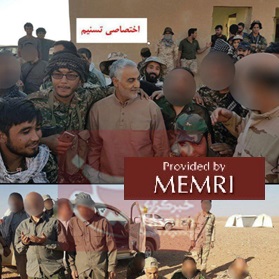
Soleimani with Fatamiyyoun Militia troops at the Syria-Iraq border (Source: @HosseinDalirian, June 12, 2017)
Al-Akhbar columnist Elie Hanna addressed this situation in an article he penned after the Syrian Army forces reached the border: „None of America’s red lines in Syria exist anymore. The decision of Damascus and its allies to reach the Iraqi border was fully implemented yesterday. Three [U.S.] attacks failed to keep them from pursuing their plans. Despite a U.S.-Russian agreement to establish a 'deconfliction line’ in the Al-Tanf area, the race towards the border [ended] yesterday with [the establishment of] a corridor, dozens of kilometers long, that prevents the Americans and their collaborators from [advancing] north of Al-Tanf… Since the start of the desert campaign, the plan of Damascus and its allies has been clear and has focused on the Iraqi border… The strategic desert campaign of advance towards the border placed IRGC Qods Force commander Qassem Soleimani in the Syrian operations room, among the forces advancing in the field… Three U.S. airstrikes intended to convey a message and trace red lines did not affect the plans. After each airstrike, the [Syrian] Army and its allies redeployed, advanced on the site of the airstrike, and continued their march towards the border… Now that America’s and Israel’s red lines have been crossed, the ball is in America’s court. The U.S. has several options. One is to accept the existing situation, i.e., stay within the 55-km area near Al-Tanf that will now serve as a safe zone for its forces and the groups working with it.
„The [second] option, of targeting the Syrian forces on the border, still exists, but now, any repetition of the previous airstrikes will fail to affect the balance of power in the field. Hence, a decision to carry out large-scale airstrikes will be tantamount to a declaration of war, whose results in the region will be unbearable for the U.S., considering the messages conveyed by Moscow, that Damascus and its allies will not cease their activity.”[13]
In a similar vein, Mundhir 'Id, columnist for the Syrian government daily Al-Thawra, wrote: „In eastern Syria, on the Iraqi border, there are undeniable developments and facts that have changed the equation. [These developments] have buried alive the American plans for safe zones here and there. The American plans to open a north-south buffer dividing Syria have become an opportunity for the Syrian military to regain [control] of all the regions controlled by ISIS. Thus, the U.S. dream to reach Deir Al-Zor, either by itself or by means of agents, has become unattainable.”[14]
The Iraqi Al-Hashd Al-Sha’bi Is Advancing Towards The Border: „The Battle Is Not Against ISIS Alone, But Also Against The Americans”
In order to completely control the border on both sides, as the forces of the Syrian regime and its allies are advancing towards the Iraqi border, the Iraqi Al-Hashd Al-Sha’bi forces are doing likewise from the opposite direction, under the command of IRGC Qods Force commander Qassem Soleimani. Senior officials in these forces have declared that their aim is to prevent ISIS from moving freely between Syria and Iraq, and that after the border is secure they will hand responsibility for it over to the Iraqi army and police, but there is no guarantee that this will happen. There is also no agreement among Al-Hashd Al-Sha’bi officials regarding the stage that will follow the capture of the border area on the Iraqi side. Some have said that they would settle for securing the border, while others have said that they would enter Syria, if necessary. For example, deputy Al-Hashd Al-Sha’bi leader Abu Mahdi Al-Muhandis said: „The Al-Hashd forces will pursue the terrorists if they threaten Iraqi areas or its national security… They will capture every part of the Iraqi border up to south of the Al-Walid crossing.” The Lebanese daily Al-Akhbar wrote that this statement shows that the Al-Hashd forces intend to take over the triangle of the Iraq-Syria-Jordan borders and part of the Iraq-Saudi border.[15]
Worse, a Al-Hashd Al-Sha’bi official told Al-Akhbar anonymously: „The battle is not against ISIS alone, but also against the Americans. We oppose their holding the central region of the border with Syria.”[16]

Soleimani (center) with Al-Hashd Al-Sha’bi forces, on the move towards the border (Source: Irdiplomacy.ir, June 1, 2016)
Jordan, Syria Are Honing Their Swords For Each Other
Jordanian King 'Abdallah: „There Is An Attempt To Create Territorial Continuity Across Iran, Iraq, Syria, And Hizbullah-Lebanon”
Along with the efforts to establish a presence at and control of the Iraq-Syria border, forces of the Syrian regime and its allies are working to establish a presence also in southern Syria, along its border with Jordan. In light of this, there is great tension also at this border, and the forces on both sides are on high alert.
Syrian opposition websites reported that the Syrian army, Hizbullah, and Shi’ite militias are sending many forces to Deraa and Al-Sweida.[17] Likewise, there were many reports in the Arab press on concentrations of American, British, Jordanian, and even Saudi forces at the Jordanian border, in advance of the Eager Lion joint military exercise, held May 7-18, 2017. The Syrian Al-Watan daily reported that the Syrian air force had stepped up its activity at the Syria-Jordan border, and that it had been instructed to „act against harm to Syrian sovereignty.”[18] On May 10, Jordan downed a Syrian drone that was circling above the border region. Jordanian government spokesman Muhammad Al-Momani explained: „The fate of anyone who approaches our border and threatens us is sealed – [it will be] death and destruction.”[19]
Jordan is extremely concerned about the developments at its northern border, and also by the presence of ISIS fighters in the region who are threatening its border and by the growing presence of Hizbullah, Shi’ite militias and the IRGC in southern Syria. These fears have also arisen in the past, but this time Jordan is expressing them more strongly, perhaps because it now has U.S. backing for action against this threat. A Washington Post interview with Jordanian King 'Abdallah before his meeting with President Trump showed that there has been a change in Jordan’s position vis-à-vis the Syria war and its ramifications, and that now the country is striving to play a more active role in defending its borders. Also in the interview, the king called ISIS and Iran threats to his kingdom, and warned that Jordan would act against these threats if they reached its borders. With regard to Iran, the king reiterated his 2004 warning about „the Shi’ite crescent”[20]: „There is an attempt to forge a geographic link between Iran, Iraq, Syria and Hezbollah/Lebanon… Iran’s strategic intent to have power there.” He stressed: ” We were very explicit… that nonstate actors from outside [i.e. Shi’ite militias] coming towards our border are not going to be tolerated.” With regard to ISIS, he expressed concern that its fighters who had fled Raqqa in Syria were heading south, but added: „[This] is a challenge, but we are ready for it in coordination with the U.S. and the British.” In contrast to his actions throughout the years of the Syria war, he now noted regarding the fate of Syrian President Bashar Al-Assad: „We all know that the Russians want [Assad] there longer than the rest of us do… Common sense dictates that somebody who is the figurehead of such bloodshed towards his people probably will move on.”[21]
Jordanian Foreign Minister Ayman Al-Safadi also called ISIS and the Shi’ite militias a threat to Jordan’s security. In a phone conversation with his Russian counterpart Sergey Lavrov, he said that Jordan „does not want terror organizations or sectarian militias at its northern border, whose security our brave armed forces and our security apparatuses are protecting.”[22]
In light of these fears, Jordan is not ruling out direct or indirect military action within Syria. King 'Abdallah and the chairman of Jordan’s joint chiefs of staff, Mahmoud Al-Freihat, have declared several times in recent weeks that Jordanian military forces would not enter Syrian territory, but did not rule out a response on its soil or activity by means of Syrian opposition forces deep within Syrian territory. King 'Abdallah said: „We will not allow developments in the Syrian and south Syrian arena to threaten Jordan… We are continuing to protect [ourselves] deep within [Syria], with no need for the Jordanian army to enter Syria…”[23] Al-Freihat said that armed forces would not enter any neighboring country „but they will strike with an iron fist anyone who tries to infiltrate our borders or threaten them in any way.”[24] The Saudi London-based daily Al-Hayat reported, on April 9, 2017, citing Jordanian sources, that there would soon be a joint Jordan-U.S.-British military operation „to eliminate terror organizations operating in the northern Syrian border [area].”[25] It added that Jordan was concerned about „the decrease in Syrian military capability [to protect] its territory and that it is transferring military activity to the Russian forces, IRGC, and Hizbullah.” The daily also noted that it had information that Jordan had carried out several ground and air operations against terrorists on Syrian soil, „but has no permanent presence there.”[26]
Syrian Foreign Minister Mu’allem: „If Jordanian Forces Enter Our Territory Without Coordinating, We Will Consider Them Hostile”
In response to these statements and reports, senior Syrian regime officials harshly criticized Jordan and its leadership. President Bashar Al-Assad castigated Jordan for what he called the role it has played, „willingly or unwillingly,” in the American plan against his country since the beginning of the Syria war, adding that Jordan is not an independent country and therefore „we do not regard it as a state but as a territory.”[27]
Syrian Foreign Minister Walid Al-Mu’allem threatened: „If Jordanian forces enter our territory without coordinating [with us], we will consider them hostile.”[28] Syrian Grand Mufti Ahmad Badreddin Hassoun said that the massing of forces on the Jordan-Syria border „does not intimidate and will not intimidate us. They will turn back, defeated…”[29]
The Lebanese daily Al-Diyar warned that if Jordan operates on Syrian soil the two countries will be „on the brink of war.” The report assessed that Syria has military supremacy because it can deploy 90 war planes and a force consisting of 20,000 Syrian troops, 6,000 Hizbullah fighters and 10,000 troops from other „ally forces.” Furthermore, Hizbullah has anti-tank missiles, and Russia has supplied Syria with advanced air-defense systems that can down Jordanian planes, whereas Jordan can deploy only 20,000 Jordanian troops and 4,000 British ones.[30]
Russia’s Position: Military Support For The Assad Regime Alongside Understandings With Syria’s Rivals, The U.S. And Jordan
Russia’s position in this matter is not completely clear. On the one hand, both the Assad regime and Russian sources are reporting that Russia is participating in the move by the Assad regime and Hizbullah in eastern Syria against the American plan. Thus, on May 8, 2017, the Syrian daily Al-Watan, which is close to the regime, reported: „Huge reinforcements of Syrian and Russian military troops have arrived in the Syrian desert region, in addition to [other] friendly forces” in advance of the operation to take over Deir Al-Zor and the Iraqi border.[31] Proof of Russian involvement was found in a post on the Facebook page of the unofficial media channel of the Russian air force base at Hmeimim, where it was reported on May 17 that soon „cooperation and military coordination on the senior level” would begin „between Syrian government forces, Iraqi government forces, and the units aiding them, in order to act against ISIS in the area of the border between the two countries. The military coordination will be done by means of Iranian military experts and in coordination with the Russian air force, in order to help the Syrian ground forces… This is a race against the armed opposition, which seeks to establish a buffer zone in front of the Golan Heights and the border with Iraq and Jordan, with direct American support.”[32]
On the other hand, it was reported that Russia was working to prevent friction between the forces of the Assad regime and its allies and the U.S. forces, and was striving to arrive at understandings with the U.S. and with Jordan with regard to the deconfliction zones in southern Syria and primarily in the Al-Tanf region, where U.S. forces and opposition forces that they support are concentrated.[33]
*N. Mozes is a Research Fellow at MEMRI.
[1] Al-Akhbar (Lebanon), June 10, 2017.
[2] Tasnim (Iran), June 13, 2017.
[3] Al-Akhbar (Lebanon), June 1, 2017.
[4] Al-Akhbar (Lebanon), June 1, 2017.
[5] Al-Akhbar (Lebanon), June 2, 2017.
[6] Harbipress.com May 9, 2017.
[7] @HosseinDalirian, June 14, 2017.
[8] English.almanar.com.lb, June 7, 2017.
[9] The last of these attacks, on June 8, 2017, resulted in the death of 60 fighters of the IRGC and the Shi’ite Al-Nujaba militia.
[10] Raialyoum.com, May 31, 2017.
[11] Syria-victory.com, June 7, 2017.
[12] Tasnim (Iran), June 13, 2017.
[13] Al-Akhbar (Lebanon), June 10, 2017.
[14] Al-Thawra (Syria), June 12, 2017.
[15] Al-Akhbar (Lebanon), June 5, 2017.
[16] Al-Akhbar (Lebanon), June 5, 2017.
[17] Enabbaladi.net, June 11, 2017.
[18] Al-Watan (Syria), May 10, 2017.
[19] Albosalka.com, May 11, 2017.
[20] A term coined by 'Abdallah in 2004 after the occupation of Iraq and Iran’s attempts to interfere in Iraqi elections. Washingtonpost.com, December 6, 2004.
[21] Washingtonpost.com, April 6, 2017. In November 2011, several months after the outbreak of the uprising against the Syrian regime, King 'Abdallah said that if Assad cared about Syria he had to step down (bbc.com, November 14, 2011). However, with the exception of this remark, throughout the Syria crisis Jordan has maintained a vague and balanced policy vis-a-vis the Assad regime. On the one hand, on the rhetoric level, Jordanian officials refrained from discussing Assad’s fate while stressing their support for a non-violent resolution that would preserve Syria’s sovereignty and integrity. This, unlike Jordan’s ally Saudi Arabia, which stated that resolving the crisis was conditional upon Assad’s removal and did not rule out a military solution. At the same time, it was reported that there are bases of the armed Syrian opposition, as well as an operations room – the Military Operations Command (MOC) – in Jordan, although Jordan denied being involved in action against Assad, stressing that the bases and the MOC were intended for action against ISIS and other terrorists groups. It should be mentioned that in December 2016-February 2017, there were many indications that Jordan was drawing closer to and Syria and its allies, Russia and Iran. There were reports on military and security cooperation between Jordan and Syria, on visits by Syrian officials in Jordan (raialyoum.com, January 26, 2017; Al-Quds Al-Arabi, London, February 9, 2017) and on a visit by a Jordanian parliamentary delegation to Iran (Al-Ghad, Jordan, February 23, 2017).
[22] Al-Dustour (Jordan), May 3, 2017
[23] Al-Ghad (Jordan), April 26, 2017.
[24] Al-Ghad (Jordan), June 6, 2017.
[25] Al-Hayat (London), April 9, 2017.
[26] Al-Hayat (London), April 23, 2017.
[27] Al-Ba’th (Syria), April 21, 2017.
[28] SANA (Syria), May 8, 2017.
[29] SANA (Syria), May 13, 2017.
[30] Al-Diyar (Lebanon), May 16, 2017.
[31] Al-Watan (Syria), May 8, 2017.
[32] Facebook.com/Russianmilitaryinsyaria, May 17, 2017.
[33] Al-Akhbar (Lebanon), May 29, 2017.
If you wish to reply, please send your email to memri@memrieurope.org.






